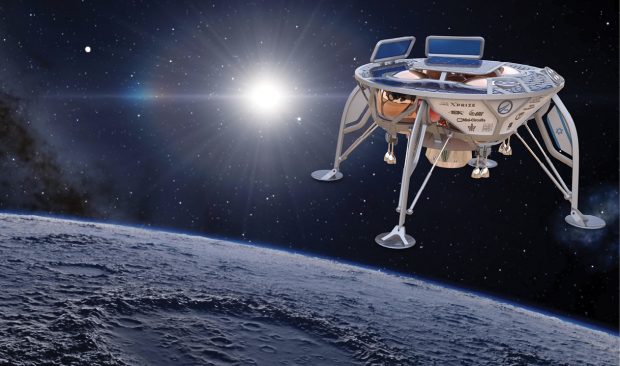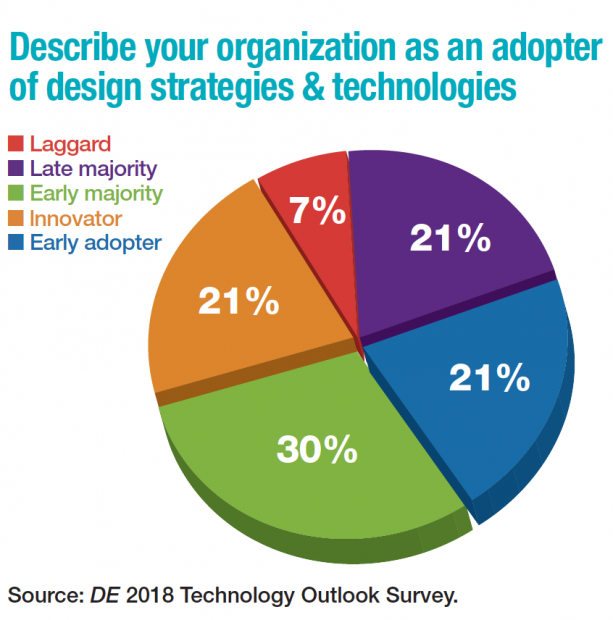
SpaceIL is using a hop concept instead of a rover, meaning the spacecraft will land on the moon’s surface and take off again with the fuel remaining in its propulsion system. Image courtesy of XPRIZE.
December 1, 2017
The final five teams from across the globe are putting finishing touches on their robotic and space-oriented technologies, all with a singular goal in mind: the moon or bust.
 SpaceIL is using a hop concept instead of a rover, meaning the spacecraft will land on the moon’s surface and take off again with the fuel remaining in its propulsion system. Image courtesy of XPRIZE.
SpaceIL is using a hop concept instead of a rover, meaning the spacecraft will land on the moon’s surface and take off again with the fuel remaining in its propulsion system. Image courtesy of XPRIZE.The deadline is March 31, 2018 for a privately funded team to effectively position a robot on the Moon’s surface that can move at least 500 meters and send high-definition video and images back to Earth. The short list of elite teams has set its sights on the $30 million Google Lunar XPRIZE ($20 million for the first to land; 2nd prize: $5 million; bonus: $5 million).
The five finalist teams that were awarded launch contracts from Google Lunar XPRIZE dating back to 2015 are:
HAKUTO (Japan); Moon Express (USA); SpaceIL (Israel); Synergy Moon (International) and TeamIndus (India).
In addition to the $30 million purse, Google Lunar XPRIZE has put $4.75 million up for grabs in the form of two prizes for teams who achieve in-space milestones on their trip to the moon. Teams can opt to pursue one or both prizes:
• Lunar Arrival $1.75M Milestone Prize—The spacecraft must make one orbit around—or a direct descent to—the moon.
• Soft Landing $3M Milestone Prize—The spacecraft must communicate information confirming its soft landing on the moon.
Private/Government Joint Exploration
An overarching aim of the competition is for technologies built by the Google Lunar XPRIZE teams to lessen costs and eliminate current obstacles so that private industry can work with government agencies to boost lunar exploration.
To accomplish this goal, Amanda Stiles, technical operations director of Google Lunar XPRIZE, explains that each team is working to drive down costs of their spacecraft in several ways:
1. using commercially available off-the-shelf (COTS) components whenever possible, which can be less costly than space-rated hardware;
2. using 3D printing to create custom components (such as wheels, for example); and,
3. using lightweight materials such as carbon fiber to construct their craft, and taking advantage of electronics miniaturization for spacecraft weight savings.
“Essentially, the lighter a spacecraft is, the less it will cost to launch it to space,” she says.
Mobility innovation is also playing a critical role in each team’s lunar efforts, according to Stiles, who comes to the XPRIZE Foundation with more than 10 years of experience in aerospace technical operations.
“The teams that are using rovers are building robust wheel and suspension systems that can stand up to the challenges of lunar dust and landscape obstacles, and some teams are also developing AI that works in tandem with the rover cameras to automatically detect and react to hazards,” she says. “Two of the finalist teams, SpaceIL and Moon Express, plan to bypass traversing the lunar surface altogether by using their propulsion systems to ‘hop’ along the lunar surface instead.
“Each team’s approach to mobility is unique, and this is an example of one of the best effects of a prize competition—the variety of innovative engineering solutions that emerge,” Stiles says.
 Another significant focal point of the competition is to promote the commercialization of private-sector space efforts.
Another significant focal point of the competition is to promote the commercialization of private-sector space efforts.
“We strongly believe that commercialization will be the key in accelerating and advancing the space exploration activities in the future,” says HAKUTO of Japan spokesman, Tomoya Mori, business development officer of ispace (a HAKUTO partner). “Space exploration is no longer governed by national agencies. Small teams like us are gathering together already available technologies to provide cheaper and more efficient ways of reaching the moon. By commercializing the space industry, we can open more opportunities for non-traditional industries to join space exploration.”
He explains that ispace, the managing company of HAKUTO, is building upon the experience and technology learned from this competition to develop a lunar resource use business and establish an economy in cislunar space—the space between the Earth and the moon. “With its micro-robotic technology, ispace plans to provide a low-cost and frequent transportation service to and on the moon. The rovers will conduct lunar surface exploration to map, process and eventually deliver resources to our customers in cislunar space,” Mori adds.
Stiles agrees that the commercialization piece of space exploration is noteworthy. “… This competition demonstrates that private citizens and companies from around the world can build spacecraft to explore the Moon, and that space exploration is no longer conducted only by a few space-faring governments.”
In the near term, Stiles says many competitors are seeking to provide payload delivery services to the Moon. “This will provide an opportunity for many scientists and engineers to send their experiments to the lunar surface to learn more about the Moon and our universe as well as test new technologies.
“As governments and companies alike make audacious plans to return humans to the moon and beyond, missions conducted by low-cost robotic ‘scouts’—such as the spacecraft being developed for the Google Lunar XPRIZE—will be critical for a variety of tasks. These missions will identify areas with high concentrations of water, ice and long periods of sunlight, which are important resources for longer-duration crewed visits to the moon, explore lunar caves that could shelter future explorers and discover locations for crewed lunar landings that are free of hazards.”
Technology Details
Though teams were reluctant to divulge too many technology secrets, SpaceIL plans to use 3D-printed legs on its unmanned lander. The legs will be provided by Zurich-based RUAG Space.
Mori also notes several companies’ involvement in HAKUTO’s efforts. For example, Zoff, a Japanese eyeglasses company, is providing ULTEM plastic to make the rover’s wheels. Similarly, Cemedine, a Japanese adhesive manufacturer, is offering adhesive to place solar panels on the rover’s sides. au/KDDI, a Japanese telecommunication company and HAKUTO’s biggest sponsor, is supporting the team with telecommunication technology.
HAKUTO’s rover, according to Mori, is built with four cameras to capture high-definition images in 360°, which will be transmitted to Earth with data-compression technology. The cameras enable a human pilot to have near real time vision of the path of the rover and guide it toward its mission.
“With our micro-robotics technology and adoption of COTS products, HAKUTO’s rover only weighs 4 kg. Compared to 900 kg of Curiosity rover on Mars or China’s 120 kg Yutu rover, our rover is extremely light and cost-efficient,” Mori says.
“HAKUTO began in a small apartment in Tokyo, initially operated by a couple volunteers,” Mori says. “Now we have over 100 members with nearly 30 sponsors. A small team with an ambitious vision can shape the future of mankind.”
More Info
Subscribe to our FREE magazine, FREE email newsletters or both!
About the Author
DE’s editors contribute news and new product announcements to Digital Engineering.
Press releases may be sent to them via [email protected].






